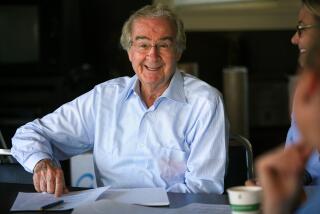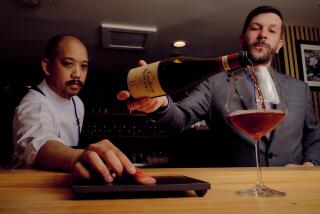Opus One: Reaching Toward a C Note
OAKVILLE — In these austere times, it might seem strange that a brand-new multimillion-dollar winery, devoted to the production of a single, very expensive wine, should have opened here two weeks ago. Opus One sells for $63 a bottle. That’s $63 for one bottle--and not a rare old bottle, but the most recent vintage.
A lot of people have a hard time understanding how any wine could be worth more than $10. Those who have discovered the attractions of great wine, however, live to get their hands on it--no matter what the price. A lot of them are not even wealthy, merely mildly insane and prepared to spend their money on wine instead of, say, shoes.
For these big spenders, Opus One has been a wine to covet since it was announced 12 years ago. The price has been startlingly high right from the first day it was offered. Call it the grandest gimmick wine of all time if you want, but Opus One is quite unlike anything in the history of the Napa Valley, perhaps in the history of wine itself.
For one thing, it’s the product of two immense egos, Robert Mondavi and the late Baron Philippe de Rothschild. Considering that winemakers rarely agree on anything, accord between these two would seem to be a monument to harmony and perhaps even world peace.
Opus One also adds an element of history and heritage to California winemaking--a melding of California grapes and French tradition. Cabernets such as Beaulieu Vineyard’s Georges de Latour Private Reserve, Ridge Monte Bello, Heitz Martha’s Vineyard, Beringer Reserve and Caymus Special Selection are beginning to accumulate a certain heritage. But only Opus has Bob and the Baron.
It’s been a big hit. Restaurateurs say that many Cabernets, including those of Beaulieu, Ridge, Heitz and Phelps, sell to wine lovers. Opus, though, sells across the board, to people who know wine and to those who know only labels and names.
Opus One came about in early 1979 when the Baron, owner of the famed Chateau Mouton-Rothschild in the Medoc region of Bordeaux, asked Mondavi whether he’d like to make a Napa Valley wine similar to Mouton as a joint project. Mondavi, never one to pass up a bold marketing idea, loved this one.
That autumn, Mondavi’s son, Tim, and Patrick Leon of Mouton assembled a Cabernet-based wine from the stocks at the Mondavi winery, across the road from what is now the Opus One winery. At the time the wine was unnamed and referred to in house simply as “Napamedoc.”
Opus One, bearing a label with silhouettes of both men, was released in 1984 and won awe-struck critical praise. From the first it has been viewed as a sublime and complex wine and--unlike a lot of other expensive Cabernets--always among the top wines of the vintage.
If anything was ever criticized, it was the price. Of course, with the prestigious names of Mondavi and Rothschild behind it, no one had seriously expected the wine would be cheap. The initial pricing of the first Opus One--at $50--was not shocking to those who realized that this price was partly set to gain attention.
It appears that the price, which at first seemed to have been put arbitrarily high, was a brilliant marketing move. At the time it was the most expensive California wine available (though it no longer is). The high price made Opus One stand out, and it gained a cachet few California wines have ever been able to attain.
Others have tried. For example, after years of making headlines with his Stag’s Leap Cask 23 Cabernet Sauvignon, Warren Winiarksi put a $75 price tag on the 1985 vintage. The market didn’t go for it, though, and a year later he meekly released his 1986 at $50.
In the beginning Opus One did have to weather some market resistance. A few years back it was moving so slowly it was sold to discount warehouses, which marketed it at $35.99. Today, though, it’s selling all of its production (12,000 cases of the 1988) without much trouble, and you rarely find it discounted much below $58. Recently a Bay Area wine shop hung out a joking sign that read, “Opus One, regularly $63, now $62.99.”
The wine itself has always been good. In the early years, because the wine was not tied to a specific vineyard site, the winemakers blended grapes from various regions to make a wine that hewed to an unwavering style.
The wine, always made at Mondavi by winemakers from both partners in the 50-50 project, was rarely as powerful as some “reserve” wines of other wineries. However, the grace and complexity of Opus One have always made it drinkable when young, unlike many of the reserves, and it has turned out to have the staying power for cellaring too. All vintages appear to be aging nicely.
Now, with a facility in which to make the wine and a vineyard of its own, Opus is no longer a wine looking for a home--it’s a real winery. The striking facility cost $15 million, says project manager Stuart Harrison, but with all the equipment in place, the expenditure must have gone well over $20 million.
Architect R. Scott Johnson, of Johnson Fain & Pereira Associates of Los Angeles, did a balancing act between the California Mission-style favored by Mondavi and the chateau concept preferred by the Baroness Philippine de Rothschild, who succeeded her father upon his death in 1988. The result is a circular building that at its perimeter appears like a Roman amphitheater, rises in the center to an upper level with an almost turret-like cupola, and includes some striking geometrical patterns.
But most people will never see the Opus One winery; it opened here to a most private public (invited guests), and the iron gate that faces Highway 29 will remain closed to casual visitors. Only those with an advance appointment may visit.
The wine also will be different from those of the past, in production if not in style. One reason is the 108 acres of vineyard planted in front of the winery, from which about half of Opus One will come. The remainder of the grapes are to be purchased from growers, as in earlier vintages.
Opus One’s own acreage is densely planted in the Bordeaux fashion, with 2,200 vines per acre, about five times as many as in the usual California planting systems. Harrison says this means the vines will compete with each other. Struggling vines, the theory says, make more complex wines.
Another difference is that with their own facility, the Opus One winemakers can make wine with more finesse. For one thing, grapes will be handled more gently than in the past. Instead of being carried in huge gondolas and dumped into a giant crusher, the grapes will be delivered to the winery in 35-pound lug boxes, hoisted to the second floor of the winery and dumped in gingerly fashion onto a fruit-sorting table where workers will remove clusters deemed unworthy.
This hand-sort system is an expensive time- and labor-intensive process that is used by some producers of sparkling wine, but rarely by makers of red wine. It required construction of a second floor through which peek the tops of the stainless-steel tanks in the room below. The grapes that pass the sorting process, crushed in a small, gentle crusher, then may be dropped directly into each tank.
The most impressive room in the facility is the glass-walled, semicircular barrel chai complete with 900 new French oak barrels ($550 each), all of them sitting in a single layer, sprayed by a mist to keep them cool and moist.
Is Opus One worth $63 a bottle? For some people, that question is silly. It is, after all, Opus One.
Wine of the Week
1990 Grand Cru Sauvignon Blanc ($9)-- This is Grand Cru’s top Sauvignon Blanc to date, a strikingly complete wine with mint and citrus, a delicate melony note, a trace of oak for complexity and a structure rich enough to match with a wide variety of lighter dishes. Grand Cru has been through a lot in the last few years. The winery was one of the sites of Ramon Salcido’s murder spree, and earlier this year a bank declined to renew the winery’s line of credit and devalued its assets. The winery, which continues to operate under protection of the bankruptcy court, announced in late October that the bankruptcy was intended “to prevent the bank lender from foreclosing on our inventory of bottled wines.” Winemaker Barbara Lindblom continues to make fine wine at Grand Cru.


